Análisis Químico y Térmico
Responsable Científico
Dr. Maria del Puerto Morales Herrero
Dr. Sabino Veintemillas Verdaguer
Personal Técnico
María del Carmen García González (Técnico Especialista de OPIS)
Carolina Chaparro Ronda (Escala Ayudantes de Investigación de OPIS)
Manuel Galera Luque (Técnico Superior FP, Garantía juvenil))
Contacto
+34 913349000 ext 437107, 437021, 437132
Localización
Analisis Químico --> Lab 107
Analisis Térmico --> Lab 021
Servicio de análisis químico
El Servicio de análisis químico permite la determinación de elementos mayoritarios, minoritarios y trazas en muestras procedentes de cualquier área científico-tecnológica.
Para garantizar unas medidas fiables y que los equipos estén en condiciones óptimas, se realizan calibrados y verificaciones periódicas y se opta por un criterio de seguridad que consiste en rechazar cualquier verificación, cuya tolerancia sea menor o igual al 10%
ICP-OES
La técnica de ICP permite la determinación cuantitativa y cualitativa de metales, metaloides y algunos elementos no metálicos, en una amplia variedad de muestras, a partir de una disolución.
La muestra líquida se transforma en un fino aerosol, mediante un sistema de nebulización y una vez en la antorcha, la muestra sufre diferentes procesos (desolvatación, vaporización, atomización, ionización y excitación). Los átomos e iones excitados emiten radiación en las zonas ultravioleta y/o visible, a longitudes de onda características de cada elemento
Equipamiento:
- Espectrómetro de Emisión Atómica por Plasma Acoplado Inductivamente (ICP)
PERKIN ELMER mod. AVIO 220MAX
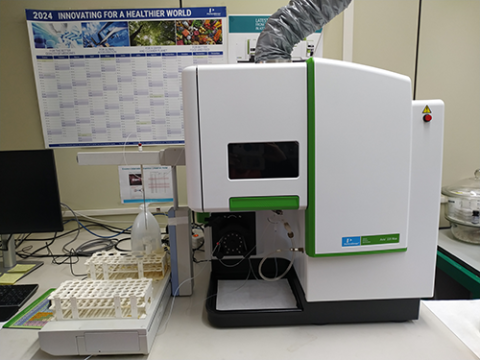
Dispone de observación automática dual del plasma (Axial y Radial) La medida en modo axial permite alcanzar los más bajos límites de detección (ppb dependiendo del elemento y tipo de muestra) mientras que con el modo radial el intervalo de concentraciones de medida es mucho más alto. El equipo abarca un amplio rango espectral entre el UV y el Visible (160-900nm) Dispone de un sistema óptico de doble monocromador, con una amplia respuesta en todo el rango espectral, pero especialmente alta en la zona del UV.
Las medidas se realizan en dos longitudes de onda para detectar posibles interferencias espectrales
Requisitos de las muestras para el ICP-OES:
El volumen mínimo de muestra ha de ser 10ml (máximo dos elementos). Para medidas de más de dos elementos consultar con el laboratorio.
Las muestras han de estar bien disueltas, sin partículas en suspensión ni precipitados.
El pH de las muestras ha de ser ligeramente ácido, utilizando como máximo un 30% de HCl concentrado o un 30% de HNO3 concentrado
No se admiten muestras en HF.
Analizador Elemental
El análisis elemental CHNS, también conocido como análisis elemental orgánico o microanálisis elemental, permite determinar las cantidades de carbono, hidrógeno, nitrógeno y azufre presentes en una muestra.
La técnica se basa en la combustión de la muestra. Los gases producidos en la combustión son medidos cuantitativamente lo que permite determinar la proporción de los elementos en la muestra original.
- Analizador elemental LECO TruSpec CHN/CHNS Micro
El equipo TruSpec Micro CHNS quema la muestra instantáneamente en un horno de alta temperatura. Esta combustión convierte el carbono en CO2, el hidrógeno en H2O, el nitrógeno en N2 y el azufre en SO2. Estos gases son arrastrados por helio y detectados por células de infrarrojos independientes, lo que permite una detección simultanea de C, H y S. El N se mide utilizando un sistema de detección de conductividad térmica.
Es una técnica muy utilizada en el control de calidad de diferentes compuestos (orgánicos, inorgánicos, compuestos organometálicos, polímeros, catalizadores…)
Es muy útil para la determinación de la pureza y homogeneidad de un compuesto y calcular su fórmula empírica
Se analizan todo tipo de muestras como composites, algas, nanoparticulas, polímeros, grafeno o biomateriales entre otras.
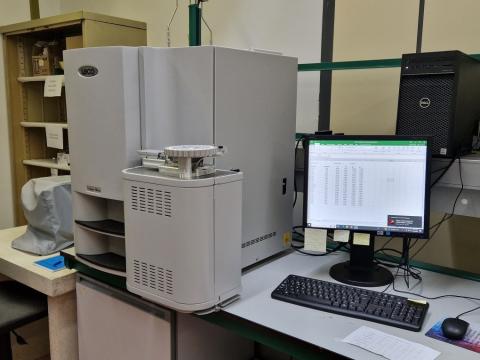
Requisitos de las muestras para el Analizador Elemental:
Las muestras deben de ser sólidas o viscosas, estar secas y ser homogéneas, deben de ser trituradas y molidas, para facilitar la combustión.
Se necesita un mínimo de 5 mg de muestra para realizar los análisis. En el caso de muestras con bajo contenido en materia orgánica, se necesitan al menos 6 mg.
Teléfono y/o correo de contacto 913349000 ext 437107, 437021, 437132
Análisis.quimico.termico@icmm.csic.es
Localización de laboratorio 107
Servicio de Análisis Térmico
El Análisis Térmico comprende varias técnicas muy útiles para la caracterización de muchos materiales diferentes: inorgánicos, orgánicos, polímeros, vidrios, productos farmacéuticos, etc.
Nuestro servicio de Análisis Térmico ofrece un conjunto de técnicas complementarias que permiten analizar en profundidad el comportamiento térmico de diferentes materiales, estudiando los cambios producidos en alguna propiedad del material en función de la temperatura, bien en procesos de calentamiento, enfriamiento o en modo isotermo, medidos todos ellos en condiciones de atmósfera controlada.
Concretamente el servicio dispone de las siguientes técnicas:
• Termogravimetría (TGA) se mide de forma continua la masa de una muestra en una atmósfera controlada, en función de la temperatura o del tiempo al ir aumentando la temperatura de la muestra de forma lineal con el tiempo.
• Análisis Térmico Diferencial (DTA) se mide la diferencia de temperatura entre una sustancia y un material de referencia aplicando una rampa de temperatura en atmósfera controlada.
• Calorimetría diferencial de barrido (DSC) para medir variaciones de entalpía o capacidad calorífica. Esta técnica rastrea la cantidad de energía requerida para aumentar la temperatura de un material en una cierta cantidad, puede detectar cambios en las propiedades del material a temperaturas exactas, revelando importantes rangos de transición y puntos de deterioro.
• TGA-espectroscopia de masas esta técnica permite el análisis simultáneo de los gases desprendidos de la termobalanza durante el análisis TGA. Esta técnica facilita la comprensión de los procesos químicos que experimenta la muestra durante el análisis.
Aplicaciones Generales:
• Análisis de la estabilidad térmica de los materiales.
• Estudio de la descomposición y oxidación de materiales.
• Determinación de la humedad y el contenido de volátiles.
• Análisis de pureza de materiales.
• Detección de la temperatura de transición vítrea, de fusión, cristalización, curado y cinética del curado.
• Determinación de entalpías de fusión y cristalización.
• Cálculo de capacidades caloríficas
El servicio de Análisis Térmico dispone del siguiente equipamiento:
- Dos termobalanzas TA Intrumets Q600 (TG/ATD/DSC). Microbalanza de alta sensibilidad para estudios de Análisis Termogravimétrico (TG), Análisis Térmico Diferencial (ATD) y Calorimetría Diferencial de Barrido (DSC) de materiales sólidos en general. Rango experimental de temperaturas: 25°C-1000°C. Velocidades de calentamiento entre 1°C/min y 100°C/min. Los estudios pueden realizarse, tanto en atmósfera inerte como en flujo de gases químicamente activos a flujos variables.
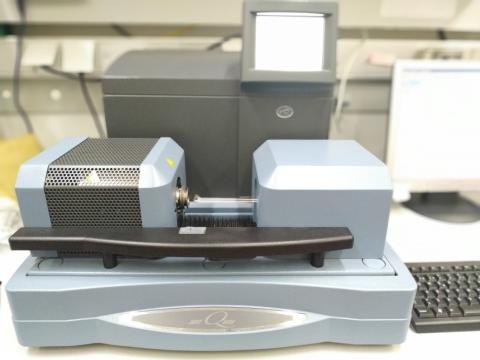
Aplicaciones habituales en Ciencia de Materiales:
• Estudios de estabilidad térmica
• Estudios de procesos de adsorción/desorción sobre superficies de materiales.
• Estudios de síntesis de catalizadores y materiales cerámicos mediante descomposición térmica de sus respectivos precursores.
• Determinación de la composición: humedad, materia volátil, cenizas y carbono.
• Estudios de comportamiento térmico de arcillas y materiales zeolíticos.
• Caracterización de materiales poliméricos.
• Determinación de pureza
Espectrómetro de masas cuadrupolar Pfeiffer Modelo: Thermostar/OmniStar para el análisis de gases (relaciones m/c 1-300 uma), dotados de con doble detector (Faraday y Channeltron) permite alcanzar una alta sensibilidad en los análisis TGA-espectroscopia de masas.
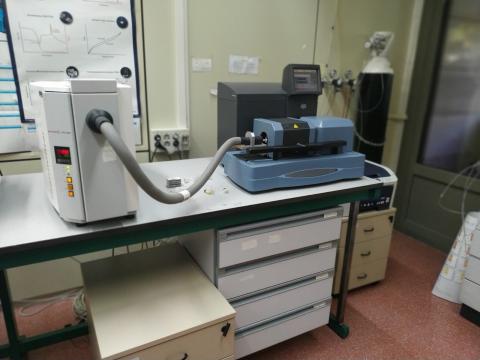
Aplicaciones habituales en Ciencia de Materiales:
• Estudio de polímeros
• Análisis de productos naturales (contaminación de suelos, arcillas, carbón)
• Fenómenos de adsorción y desorción en catalizadores
• Procesos térmicos sobre materiales inorgánicos en estado sólido ( reacciones y cambios de estequiometria)
• Estudios de productos farmacéuticos (estabilidad, restos de disolvente, efectos de la formulación)- El calorímetro diferencial de barrido (DSC-MDSC) Q2000 TA Instruments analiza entre -150ºC hasta 500ºC principalmente en muestras sólidas en atmósferas no reactivas. El DSC convencional mide el flujo de calor relacionado con la transición de fases de materiales en función del tiempo y la temperatura. Los resultados del ensayo proporcionan una información cualitativa y cuantitativa de los cambios físicos y químicos que generan una reacción endotérmica o exotérmica.
En modo DSC modulado (MDSC), mediante la tecnología de modulación de la temperatura, se superpone un programa de temperatura sinusoidal al perfil de temperatura lineal convencional, permitiendo separar el flujo total de calor en la componente cinética y la termodinámica (Cp). 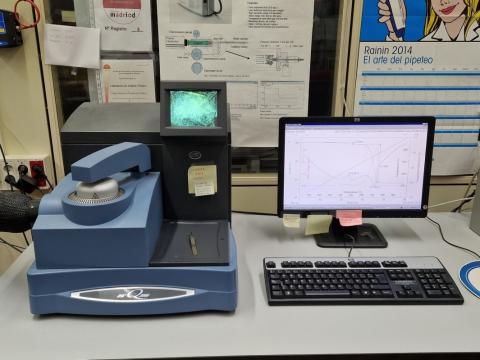
Aplicaciones en Ciencia de Materiales:
• Estudio de transiciones de fase que incluye: Temperatura de fusión (Tm), Calor de fusión (ΔHm), Transición vítrea (Tg) y Temperatura de cristalización (Tc)
• Medida directa de capacidades caloríficas
• Estudios de polimorfismo
• Historia térmica
• Determinación de entalpías de reacción
• Determinación de tiempo y temperatura de inducción a la oxidación (OITM/OITP)
Tipo de muestras analizadas
Las muestras deben estar convenientemente envasadas y etiquetadas. En cada muestra debe aparecer de manera clara, visible e indeleble el código de identificación que debe coincidir con el código designado en la solicitud de análisis.
En función de la composición y toxicidad de las muestras, el servicio se reserva el derecho a declinar el análisis.
Requisitos de la muestra:: La cantidad mínima recomendada es de 10mg, aunque esto puede variar en función de la naturaleza de la muestra.
Ante cualquier duda contactar con el servicio.
Teléfono y/o correo de contacto 913349000 ext 437107, 437021, 437132
análisis.quimico.termico@icmm.csic.es
Localización de laboratorio 021
ICMM
Sor Juana Ines de la Cruz, 3
Cantoblanco, 28049
Madrid, España
Teléfono: (+34) 91 334 90 00
Email: @email
Comunicación: @email

Contacto | Accesibilidad | Aviso legal | Política de Cookies | Protección de datos




